20CR Atmospheric Climate Indices and Teleconnections
| Climate Index 20CRV3 | Description | Annual Average Plot | Spatial Pattern |
|---|---|---|---|
| Southern Annular Mode (SAM) Data Values: PSL format, CSV, NetCDF NCL Code | This mode describes low frequency variability of the Southern Hemisphere extratropics. It is defined as the zonal mean SLP difference of 65S and 40S.A positive index (lower polar pressure) is associated with weaker, zonal winds in the extratropics. A negative value is associated with stronger zonal winds. | 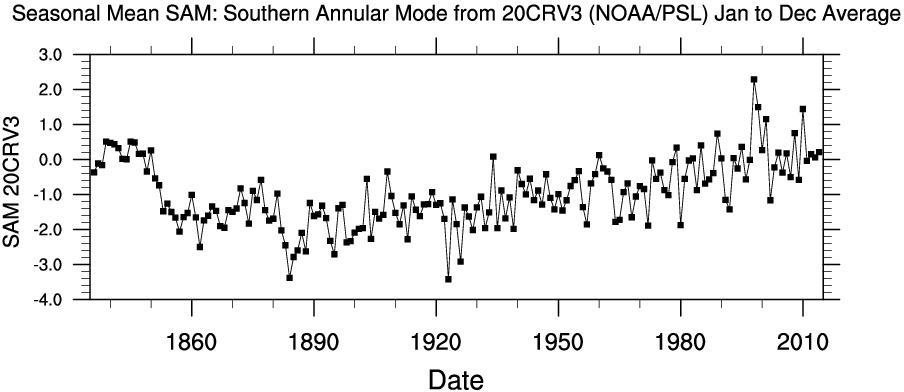 | 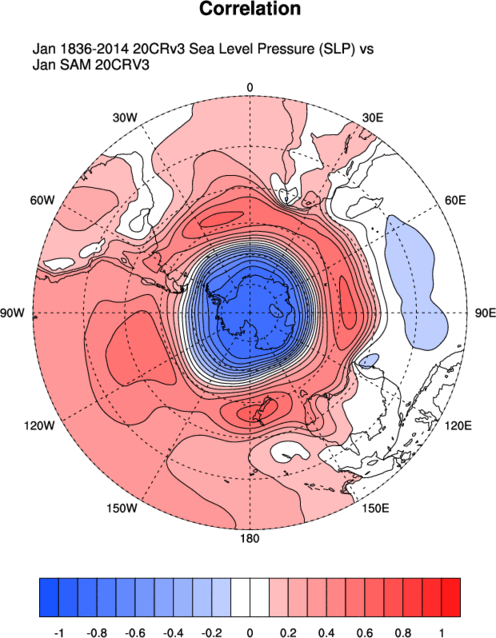 |
| North Pacific Index (NP) Data Values: PSL format, CSV, NetCDF NCL Code | The North Pacific (NP) Index is defined here as the area-weighted sea level pressure over the region 30°N-65°, 160°E-140°W. The NP index is defined to measure interannual to decadal variations in the atmospheric circulation. | 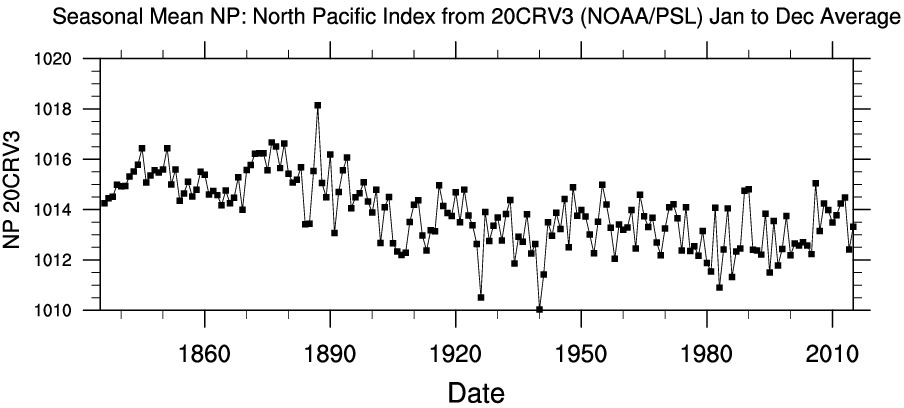 | 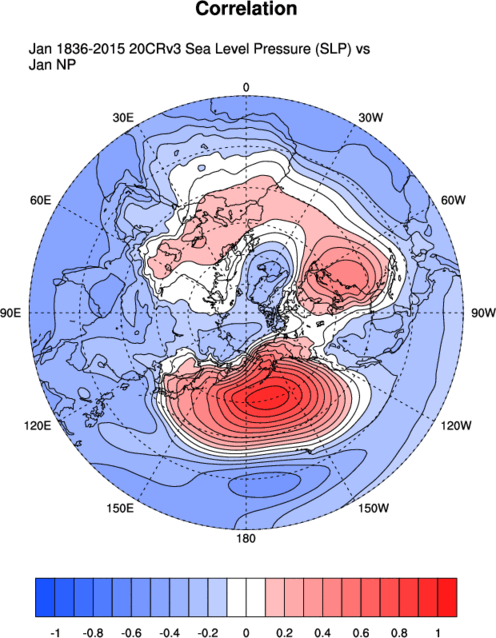 |
| Arctic Oscillation (AO) Data Values: PSL format, CSV, NetCDF NCL Code | This mode describes low frequency variability of the Northern Hemisphere extratropics. We use the definition of the 1st EOF of monthly SLP anomalies from 20N to the pole. A positive index (low polar pressure) is associated with a stronger, more zonal winds in the extratropics. A negative value is associated with less zonal winds and more incursions of Arctic air into the Northern Hemisphere. | 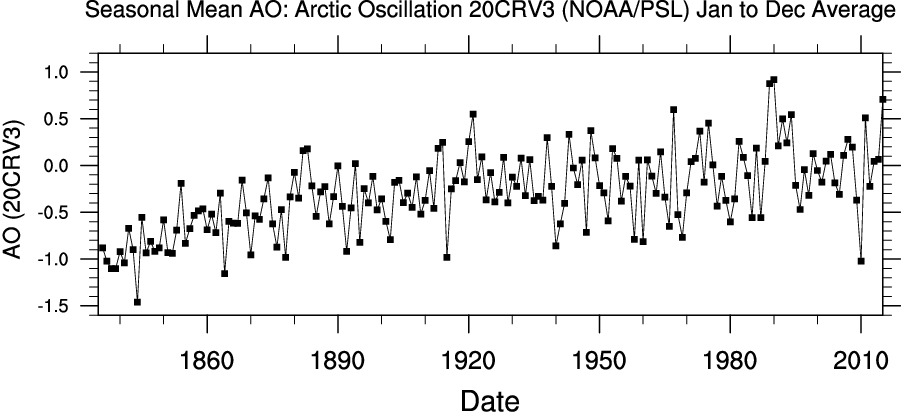 | 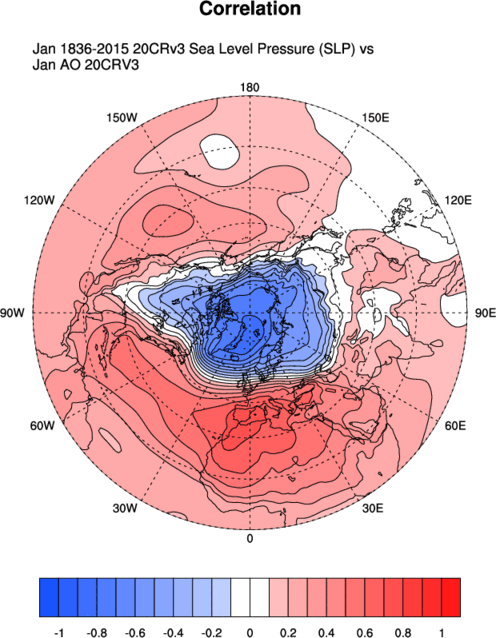 |
| Antarctic Oscillation (AAO) Data Values: PSL format, CSV, NetCDF NCL Code | This mode describes low frequency variability of the Southern Hemisphere extratropics. It is defined here using the 1st EOF of SLP from 20S to the pole. A positive index (lower polar pressure) is associated with stronger, zonal winds in the extratropics. A negative value is associated with weaker zonal winds. | 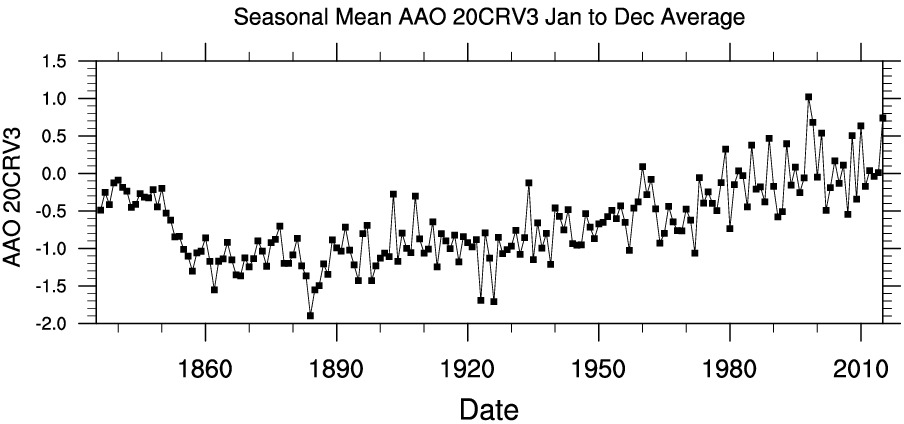 | 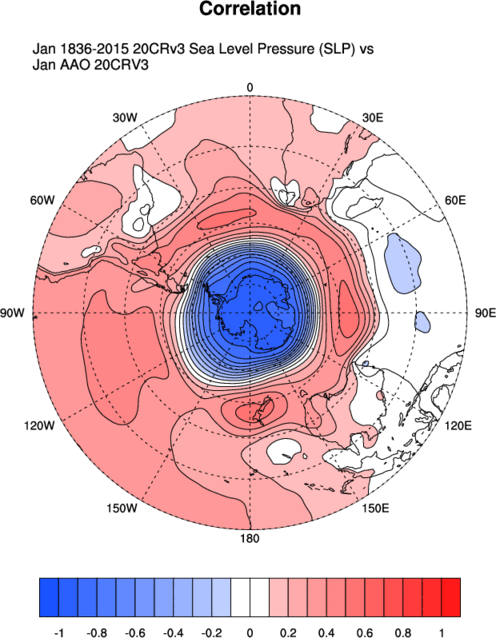 |
| Greenland Blocking Index (GBI) Data Values: PSL format, CSV, NetCDF NCL Code | GBI is the mean 500 hPa geopotential height for the 60-80°N, 20-80°W region. It measures blocking over Greenland which impacts both climate and weather in the Northern Hemisphere. |  | 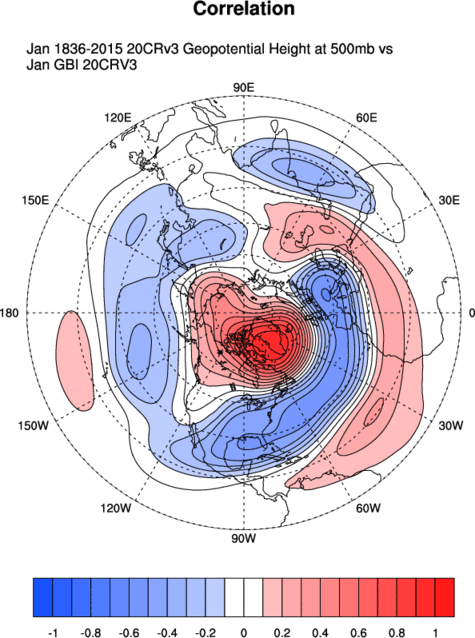 |
| North Atlantic Oscillation (NAO) Data Values: PSL format, CSV, NetCDF NCL Code | This mode describes variability over the northern Atlantic ocean, eastern North America and western Europe. The NAO represents the relative strength of the Icelandic low and the Azores high. We used the 'station based' approach of using the SLP anomaly differences in grids closest to Lisbon, Portugal and Reykjavík, Iceland (37.71,9.14W;64.13N,21.93W ) though there are other definitions. | 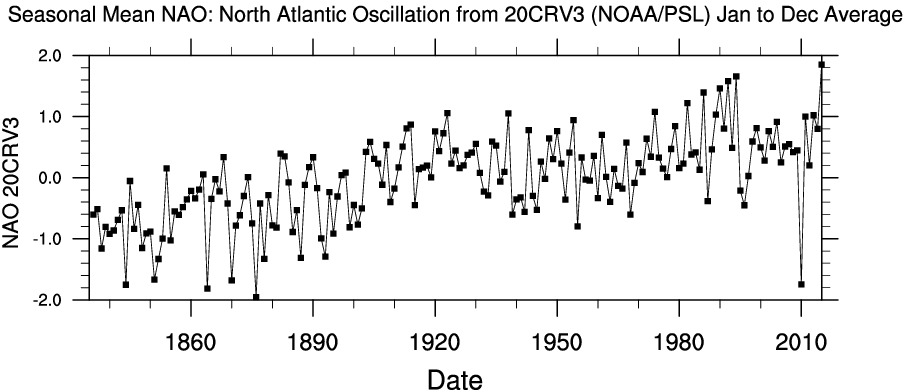 | 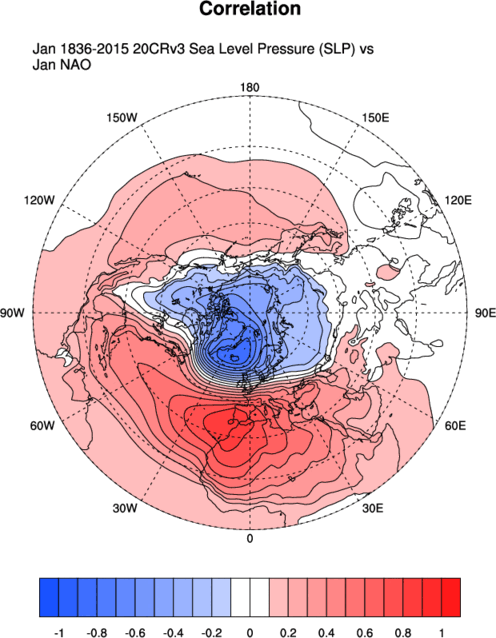 |
| Southern Oscillation (SOI) Data Values: PSL format, CSV, NetCDF NCL Code | This mode describes variability of the tropical atmosphere. It is often used as a measure of El Niño/La Niña and is correlated highly with ENSO indices. A high value represents higher surface pressure in the eastern tropical Pacific with more typical easterlies along the equator and is associated with La Niña's. A low value is associated with tropical surface westerlies and El Niños. | 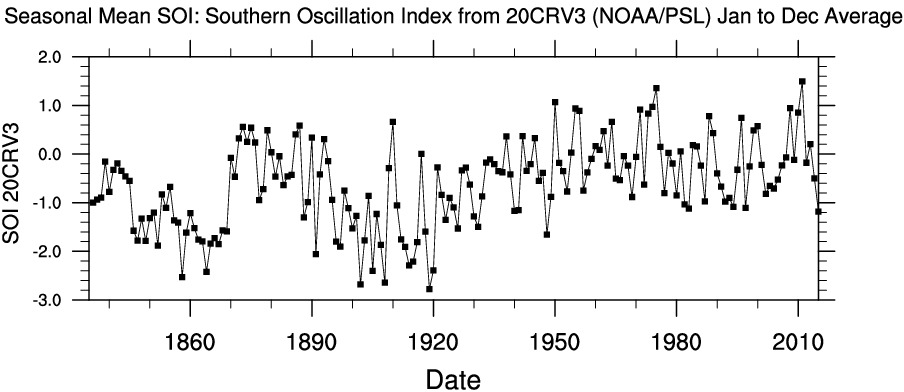 | 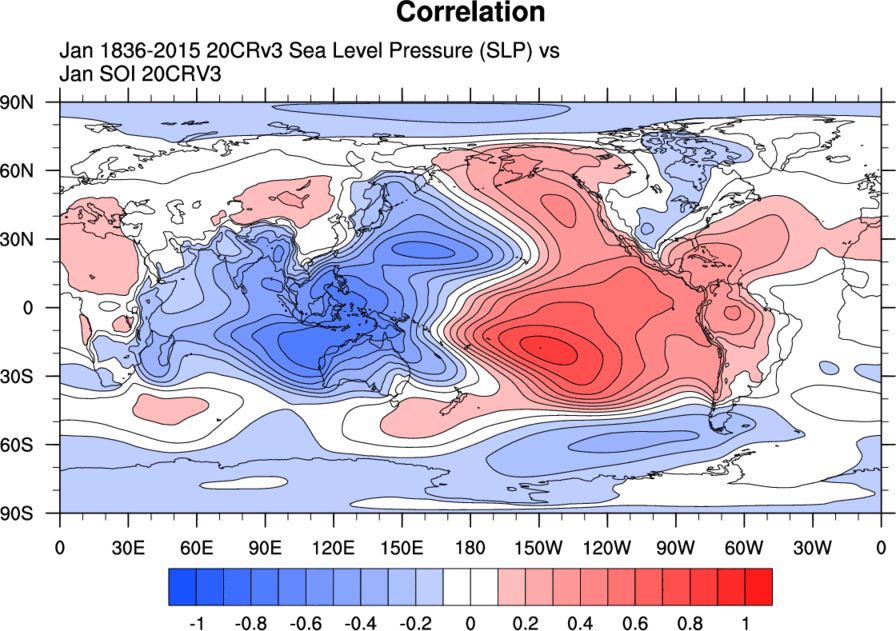 |
| Pacific North American Pattern (PNA) Data Values: PSL format, CSV, NetCDF NCL Code | The Pacific/ North American teleconnection pattern (PNA) is one of the most prominent modes of low-frequency variability in the Northern Hemisphere extratropics. The positive phase of the PNA pattern features above-average heights in the vicinity of Hawaii and over the intermountain region of North America, and below-average heights located south of the Aleutian Islands and over the southeastern United States. The method for this PNA is to use a combination of four "centers" of 500mb geopotential height. | 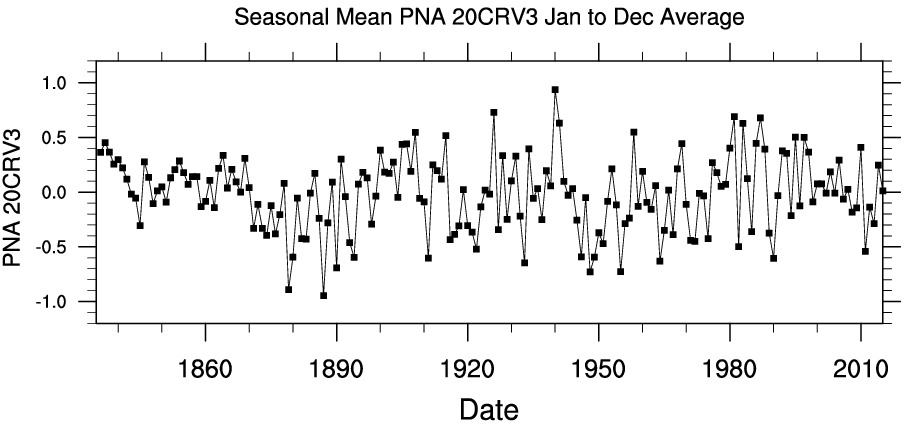 | 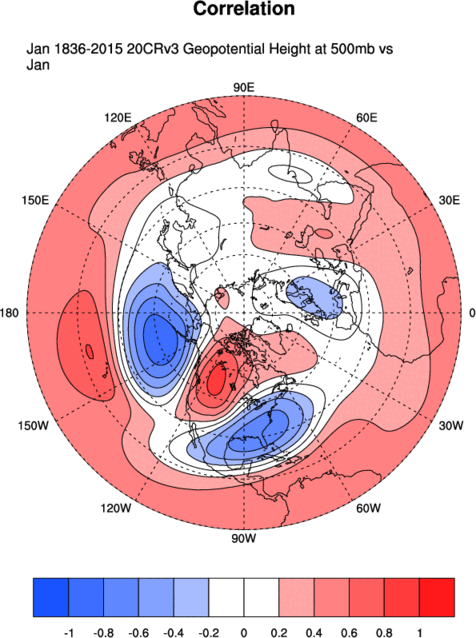 |
| Walker Index Data Values: PSL format, CSV, NetCDF NCL Code | The Walker index is a measure of east/west circulation over the tropical Pacific ocean. It is calculated using the difference of the SLP averaged over 5S-5N; 80E-160E and 5S-5N; 200-280E. | 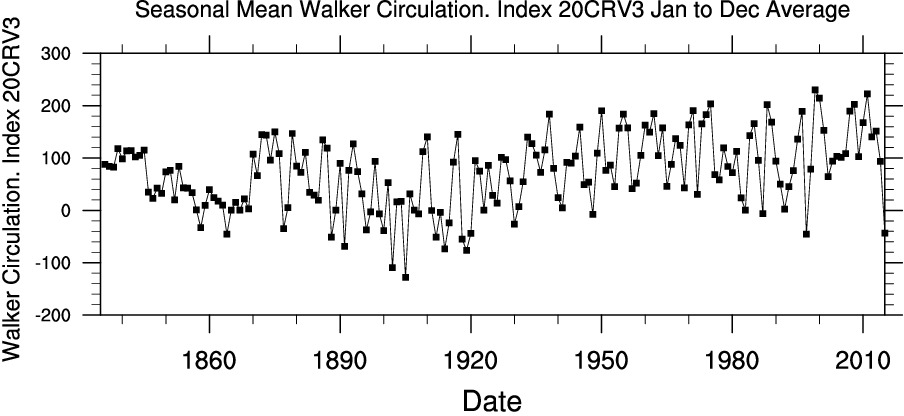 | 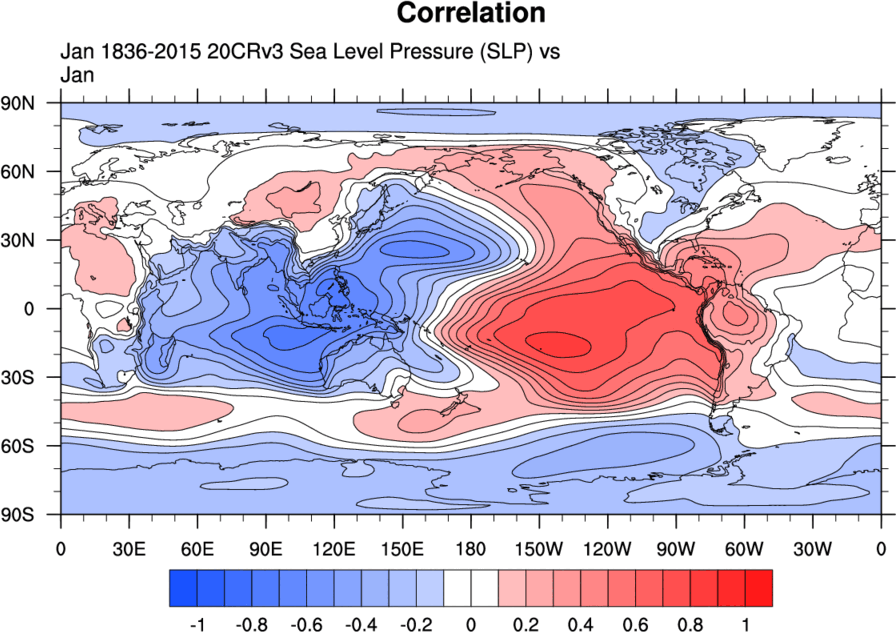 |
| Climate Index 20CRV3 | Description | Spatial Pattern |
|---|---|---|
| Arctic Oscillation Data Values: ASCII NCL Code | This mode describes low frequency variability of the Northern Hemisphere extratropics. We use the definition of the 1st EOF of monthly SLP anomalies from 20N to the pole. Daily values are generated by projecting SLP onto the EOF pattern. A positive index (low polar pressure) is associated with a stronger, more zonal winds in the extratropics. A negative value is associated with less zonal winds and more incursions of Arctic air into the Northern Hemisphere. |  |
Web Tools to Plot/Use 20CR Climate Indices
- WRIT Time-series Plotting and Analysis Page. Allows plotting, analysis, and comparisons of pregenerated 20CR indices and many other indices and time-series obtained from gridded datasets.
- WRIT Correlation Plotting Page. Allows calculation of correlations of a time-series with maps and vertical cross-sections of reanalyses and observational datasets. Some 20CR indices are included
Related Sites
- NOAA CPC Teleconnection Webpage and Monthly Teleconnection Webpage.
- Includes the definitions CPC uses for teleconnection, data, descriptions of the patterns, and plots.
- NOAA Climate.gov teleconnections blog post: Description of what teleconnections are and what causes them more generally.
Publications
Selected Key Teleconnection Publications
- Walker, G.T. and Bliss, E.W., 1932: World Weather V. Memoirs of the Royal Meteorological Society, 4, 53-84.
- J. Bjerknes, 1969: Atmospheric teleconnections from the equatorial pacific. DOI: https://doi.org/10.1175/1520-0493(1969)097<0163:ATFTEP>2.3.CO;2 Monthly Weather Review, 163–172
- Van Loon, Harry, and Jeffery C. Rogers. 1978: "The seesaw in winter temperatures between Greenland and northern Europe. Part I: General description." Monthly Weather Review 106.3: 296-310.
- J. Horel and Wallace, JM., 1981: Planetary-Scale Atmospheric Phenomena Associated with the Southern Oscillation Monthly Weather Review 109(4):813-829 DOI:10.1175/1520-0493(1981)109<0813:PSAPAW>2.0.CO;2
- van Loon, H., and R.A. Madden, 1981: The Southern Oscillation. Part I: Global associations with pressure and temperature in Northern winter. Mon. Wea. Rev., 109, 1150-1162.
- Barnston, A. G., and R. E. Livezey, 1987: Classification, seasonality and persistence of low-frequency atmospheric circulation patterns. Mon. Wea. Rev., 115, 1083-1126.
- Stephenson, David B., et al. "The history of scientific research on the North Atlantic Oscillation." Geophysical monograph-American Geophysical Union 134 (2003): 37-50.
20CR Atmospheric Telecoinnection Publications
- Feng, X. F., and Coauthors, 2021: A Multidecadal-Scale Tropically Driven Global Teleconnection over the Past Millennium and Its Recent Strengthening. J. Clim., 34, 2549-2565, doi:10.1175/jcli-d-20-0216.1.
- Agrawal, S., C. R. Ferguson, L. Bosart, and D. A. Burrows, 2021: Teleconnections Governing the Interannual Variability of Great Plains Low-Level Jets in May. J. Clim., 34, 4785-4802, doi:10.1175/jcli-d-20-0451.1.
- Bodai, T., G. Drotos, K. J. Ha, J. Y. Lee, and E. S. Chung, 2021: Nonlinear Forced Change and Nonergodicity: The Case of ENSO-Indian Monsoon and Global Precipitation Teleconnections. Frontiers in Earth Science, 8, doi:10.3389/feart.2020.599785.
- Chen, Y., and Coauthors, 2023: Weakened western Pacific teleconnection pattern caused a decrease in spring persistent rainfall in north of 26 degrees N over Southeast China. International Journal of Climatology, 43, 4337-4346, doi:10.1002/joc.8090.
- King, M. P., N. Keenlyside, and C. Li, 2023: ENSO teleconnections in terms of non-NAO and NAO atmospheric variability. Climate Dynamics, doi:10.1007/s00382-023-06697-8.
- Dalelane, C., K. Winderlich, and A. Walter, 2023: Evaluation of global teleconnections in CMIP6 climate projections using complex networks. Earth System Dynamics, 14, 17-37, doi:10.5194/esd-14-17-2023.
- Hao, X., H. J. Wang, B. T. Zhou, J. D. Li, J. F. Wei, and T. T. Han, 2023: Ocean Surface Warming Pattern Inhibits El Nin?o-Induced Atmospheric Teleconnections. J. Clim., 36, 1521-1539, doi:10.1175/jcli-d-22-0275.1. Dutta, A., and J. M. Neena, 2022: Exploring the circum-global teleconnection-Indian summer monsoon interactions in the interannual and multidecadal timescales. Frontiers in Earth Science, 10, doi:10.3389/feart.2022.973468. Dwivedi, S., P. Pandey, and B. N. Goswami, 2022: Nonstationarity and potential multi-decadal variability in Indian Summer Monsoon Rainfall and Southern Annular Mode teleconnection. Climate Dynamics, 59, 671-683, doi:10.1007/s00382-022-06146-y.
- Lieber, R., A. King, J. Brown, L. Ashcroft, M. Freund, and C. McMichael, 2022: ENSO Teleconnections More Uncertain in Regions of Lower Socioeconomic Development. Geophysical Research Letters, 49, doi:10.1029/2022gl100553.
- Mezzina, B., J. Garcia-Serrano, T. Ambrizzi, D. Matei, E. Manzini, and I. Blade, 2023: Tropospheric pathways of the late-winter ENSO teleconnection to Europe. Climate Dynamics, 60, 3307-3317, doi:10.1007/s00382-022-06508-6.
- Roibu, C. C., V. Nagavciuc, M. Ionita, I. Popa, S. A. Horodnic, A. Mursa, and U. Buntgen, 2022: A tree ring-based hydroclimate reconstruction for eastern Europe reveals large-scale teleconnection patterns. Climate Dynamics, 59, 2979-2994, doi:10.1007/s00382-022-06255-8.
- Xu, T. F., D. L. Yuan, and J. Wang, 2022: Assessment of the oceanic channel dynamics responsible for the IOD-ENSO precursory teleconnection in CMIP5 climate models. Frontiers in Climate, 4, doi:10.3389/fclim.2022.996343.
- Jacques-Coper, M., D. Veloso-Aguila, C. Segura, and A. Valencia, 2021: Intraseasonal teleconnections leading to heat waves in central Chile. International Journal of Climatology, 41, 4712-4731, doi:10.1002/joc.7096.
- Mahendra, N., J. S. Chowdary, P. Darshana, P. Sunitha, A. Parekh, and C. Gnanaseelan, 2021: Interdecadal modulation of interannual ENSO-Indian summer monsoon rainfall teleconnections in observations and CMIP6 models: Regional patterns. International Journal of Climatology, 41, 2528-2552, doi:10.1002/joc.6973.
- Sanchez, S. C., G. J. Hakim, and C. P. Saenger, 2021: Climate Model Teleconnection Patterns Govern the Nino-3.4 Response to Early Nineteenth-Century Volcanism in Coral-Based Data Assimilation Reconstructions. J. Clim., 34, 1863-1880, doi:10.1175/jcli-d-20-0549.1.
- Zahan, Y., P. V. Rajesh, B. A. Choudhury, and B. N. Goswami, 2021: Why Indian summer monsoon circulation indices? Fidelity in representing rainfall variability and teleconnections. Quarterly Journal of the Royal Meteorological Society, 147, 1300-1316, doi:10.1002/qj.3972.
- Mezzina, B., J. Garcia-Serrano, I. Blade, and F. Kucharski, 2020: Dynamics of the ENSO Teleconnection and NAO Variability in the North Atlantic-European Late Winter. J. Clim., 33, 907-923, doi:10.1175/jcli-d-19-0192.1.
- Molteni, F., and Coauthors, 2020: Boreal-winter teleconnections with tropical Indo-Pacific rainfall in HighResMIP historical simulations from the PRIMAVERA project. Climate Dynamics, 55, 1843-1873, doi:10.1007/s00382-020-05358-4.
- Babolcsai, G., and T. Hirsch, 2019: Teleconnection between mean sea level pressure in the North Atlantic for September, the AMO phase and mean temperature in Central Europe for December (1896-2015). Meteorological Applications, 26, 267-274, doi:10.1002/met.1760. < li>Dinis, L., C. Begin, M. M. Savard, J. Marion, P. Brigode, and C. Alvarez, 2019: Tree-ring stable isotopes for regional discharge reconstruction in eastern Labrador and teleconnection with the Arctic Oscillation. Climate Dynamics, 53, 3625-3640, doi:10.1007/s00382-019-04731-2.
- Joshi, M. K., and K. J. Ha, 2019: Fidelity of CMIP5-simulated teleconnection between Atlantic multidecadal oscillation and Indian summer monsoon rainfall. Climate Dynamics, 52, 4157-4176, doi:10.1007/s00382-018-4376-z.
- Kayano, M. T., R. V. Andreoli, and R. A. F. de Souza, 2019: El Nino-Southern Oscillation related teleconnections over South America under distinct Atlantic Multidecadal Oscillation and Pacific Interdecadal Oscillation backgrounds: La Nina. International Journal of Climatology, 39, 1359-1372, doi:10.1002/joc.5886. ,li>O'Reilly, C. H., T. Woollings, L. Zanna, and A. Weisheimer, 2019: An Interdecadal Shift of the Extratropical Teleconnection From the Tropical Pacific During Boreal Summer. Geophysical Research Letters, 46, 13379-13388, doi:10.1029/2019gl084079.
- Park, J. H., and T. Li, 2019: Interdecadal modulation of El Nino-tropical North Atlantic teleconnection by the Atlantic multi-decadal oscillation. Climate Dynamics, 52, 5345-5360, doi:10.1007/s00382-018-4452-4.
- Serykh, I. V., D. M. Sonechkin, V. I. Byshev, V. G. Neiman, and Y. A. Romanov, 2019: Global Atmospheric Oscillation: An Integrity of ENSO and Extratropical Teleconnections. Pure and Applied Geophysics, 176, 3737-3755, doi:10.1007/s00024-019-02182-8.
- Yang, Y., T. Y. Gan, and X. Z. Tan, 2019: Spatiotemporal Changes in Precipitation Extremes over Canada and Their Teleconnections to Large-Scale Climate Patterns. Journal of Hydrometeorology, 20, 275-296, doi:10.1175/jhm-d-18-0004.1.
- Yu, B., and H. Lin, 2019: Modification of the wintertime Pacific-North American pattern related North American climate anomalies by the Asian-Bering-North American teleconnection. Climate Dynamics, 53, 313-328, doi:10.1007/s00382-018-4586-4.
- Yu, B., H. Lin, and N. Soulard, 2019: A Comparison of North American Surface Temperature and Temperature Extreme Anomalies in Association with Various Atmospheric Teleconnection Patterns. Atmosphere, 10, doi:10.3390/atmos10040172.
- Chen, Z., B. L. Gan, L. X. Wu, and F. Jia, 2018: Pacific-North American teleconnection and North Pacific Oscillation: historical simulation and future projection in CMIP5 models. Climate Dynamics, 50, 4379-4403, doi:10.1007/s00382-017-3881-9.
- Datwyler, C., and Coauthors, 2018: Teleconnection stationarity, variability and trends of the Southern Annular Mode (SAM) during the last millennium. Climate Dynamics, 51, 2321-2339, doi:10.1007/s00382-017-4015-0.
- affres, J. B. D., C. Cuff, C. Rasmussen, and A. S. Hesson, 2018: Teleconnection of atmospheric and oceanic climate anomalies with Australian weather patterns: a review of data availability. Earth-Science Reviews, 176, 117-146, doi:10.1016/j.earscirev.2017.08.010.
- King, M. P., I. Herceg-Bulic, F. Kucharski, and N. Keenlyside, 2018: Interannual tropical Pacific sea surface temperature anomalies teleconnection to Northern Hemisphere atmosphere in November. Climate Dynamics, 50, 1881-1899, doi:10.1007/s00382-017-3727-5.
- Mamalakis, A., J. Y. Yu, J. T. Randerson, A. AghaKouchak, and E. Foufoula-Georgiou, 2018: A new interhemispheric teleconnection increases predictability of winter precipitation in southwestern US. Nature Communications, 9, doi:10.1038/s41467-018-04722-7.
- Xue, J. Q., C. Sun, J. P. Li, and J. Y. Mao, 2018: South Atlantic Forced Multidecadal Teleconnection to the Midlatitude South Indian Ocean. Geophysical Research Letters, 45, 8480-8489, doi:10.1029/2018gl078990.
- Masina, S., and A. Storto, 2017: Reconstructing the recent past ocean variability: Status and perspective. Journal of Marine Research, 75, 727-764, doi:McAfee, S. A., 2017: Uncertainty in Pacific decadal oscillation indices does not contribute to teleconnection instability. International Journal of Climatology, 37, 3509-3516, doi:10.1002/joc.4918.
- Peings, Y., H. Douville, J. Colin, D. Saint Martin, and G. Magnusdottir, 2017: Snow-(N)AO Teleconnection and Its Modulation by the Quasi-Biennial Oscillation. J. Clim., 30, 10211-10235, doi:10.1175/jcli-d-17-0041.1.
- un, C., J. P. Li, R. Q. Ding, and Z. Jin, 2017: Cold season Africa-Asia multidecadal teleconnection pattern and its relation to the Atlantic multidecadal variability. Climate Dynamics, 48, 3903-3918, doi:10.1007/s00382-016-3309-y.
- Vitart, F., 2017: Madden - Julian Oscillation prediction and teleconnections in the S2S database. Quarterly Journal of the Royal Meteorological Society, 143, 2210-2220, doi:10.1002/qj.3079.
- Ashcroft, L., J. Gergis, and D. J. Karoly, 2016: Long-term stationarity of El Nino-Southern Oscillation teleconnections in southeastern Australia. Climate Dynamics, 46, 2991-3006, doi:10.1007/s00382-015-2746-3.
- Chervenkov, H., I. Tsonevsky, and K. Slavov, 2016: Drought Events Assessment and Trend Estimation - Results from the Analysis of Long-Term Time Series of the Standardized Precipitation Index. Comptes Rendus De L Academie Bulgare Des Sciences, 69, 983-994, doi:Ciarlo, J. M., and N. J. Aquilina, 2016: An analysis of teleconnections in the Mediterranean region using RegCM4. International Journal of Climatology, 36, 797-808, doi:10.1002/joc.4383.
- Dieppois, B., B. Pohl, M. Rouault, M. New, D. Lawler, and N. Keenlyside, 2016: Interannual to interdecadal variability of winter and summer southern African rainfall, and their teleconnections. Journal of Geophysical Research-Atmospheres, 121, 6215-6239, doi:10.1002/2015JD024576.
- Jia, F., L. Wu, B. Gan, and W. Cai, 2016: Global Warming Attenuates the Tropical Atlantic-Pacific Teleconnection. Scientific Reports, 6, doi:10.1038/srep20078.
- Kucharski, F., and Coauthors, 2016: The Teleconnection of the Tropical Atlantic to Indo-Pacific Sea Surface Temperatures on Inter-Annual to Centennial Time Scales: A Review of Recent Findings. Atmosphere, 7, doi:10.3390/atmos7020029.
- Lin, J.-S., B. Wu, and T.-J. Zhou, 2016: Is the interdecadal circumglobal teleconnection pattern excited by the Atlantic multidecadal Oscillation? Atmospheric and Oceanic Science Letters, 9, 451-457, doi:10.1080/16742834.2016.1233800.
- Wu, B., J. Lin, and T. Zhou, 2016: Interdecadal circumglobal teleconnection pattern during boreal summer. Atmospheric Science Letters, 17, 446-452, doi:10.1002/asl.677.
- Wu, B., T. Zhou, and T. Li, 2016: Impacts of the Pacific-Japan and Circumglobal Teleconnection Patterns on the Interdecadal Variability of the East Asian Summer Monsoon. J. Clim., 29, 3253-3271, doi:10.1175/JCLI-D-15-0105.1.
- Fang, K., H. Seppa, and D. Chen, 2015: Interdecadal hydroclimate teleconnections between Asia and North America over the past 600 years. Climate Dynamics, 44, 1777-1787, doi:10.1007/s00382-014-2266-6.
- Gonzalez-Reviriego, N., C. Rodriguez-Puebla, and B. Rodriguez-Fonseca, 2015: Evaluation of observed and simulated teleconnections over the Euro-Atlantic region on the basis of partial least squares regression. Climate Dynamics, 44, 2989-3014, doi:10.1007/s00382-014-2367-2.
- Ott, I., K. Romberg, and J. Jacobeit, 2015: Teleconnections of the tropical Atlantic and Pacific Oceans in a CMIP5 model ensemble. Climate Dynamics, 44, 3043-3055, doi:10.1007/s00382-014-2394-z.
- Reboita, M. S., R. P. da Rocha, T. Ambrizzi, and C. D. Gouveia, 2015: Trend and teleconnection patterns in the climatology of extratropical cyclones over the Southern Hemisphere. Climate Dynamics, 45, 1929-1944, doi:10.1007/s00382-014-2447-3.
- Richter, J. H., C. Deser, and L. Sun, 2015: Effects of stratospheric variability on El Nino teleconnections. Environmental Research Letters, 10, doi:10.1088/1748-9326/10/12/124021.
- Risbey, J. S., T. J. O'Kane, D. P. Monselesan, C. Franzke, and I. Horenko, 2015: Metastability of Northern Hemisphere Teleconnection Modes. J Atmos Sci, 72, 35-54, doi:10.1175/JAS-D-14-0020.1.
- Sun, C., J. Li, J. Feng, and F. Xie, 2015: A Decadal-Scale Teleconnection between the North Atlantic Oscillation and Subtropical Eastern Australian Rainfall. J. Clim., 28, 1074-1092, doi:10.1175/JCLI-D-14-00372.1.
- Wise, E. K., M. L. Wrzesien, M. P. Dannenberg, and D. L. McGinnis, 2015: Cool-Season Precipitation Patterns Associated with Teleconnection Interactions in the United States. Journal of Applied Meteorology and Climatology, 54, 494-505, doi:10.1175/JAMC-D-14-0040.1.
- Jacques-Coper, M., and S. Broennimann, 2014: Summer temperature in the eastern part of southern South America: its variability in the twentieth century and a teleconnection with Oceania. Climate Dynamics, 43, 2111-2130, doi:10.1007/s00382-013-2038-8.
- Liu, Y., L. Wang, W. Zhou, and W. Chen, 2014: Three Eurasian teleconnection patterns: spatial structures, temporal variability, and associated winter climate anomalies. Climate Dynamics, 42, 2817-2839, doi:10.1007/s00382-014-2163-z.
- Nicholson, S. E., 2014: Spatial teleconnections in African rainfall: A comparison of 19th and 20th century patterns. Holocene, 24, 1840-1848, doi:10.1177/0959683614551230.
- Wang, S.-Y., R. R. Gillies, and T. Reichler, 2012: Multidecadal Drought Cycles in the Great Basin Recorded by the Great Salt Lake: Modulation from a Transition-Phase Teleconnection. J. Clim., 25, 1711-1721, doi:10.1175/2011JCLI4225.1.
- Linderholm, H. W., and Coauthors, 2011: Interannual teleconnections between the summer North Atlantic Oscillation and the East Asian summer monsoon. Journal of Geophysical Research-Atmospheres, 116, doi:10.1029/2010JD015235.